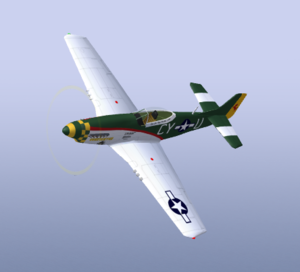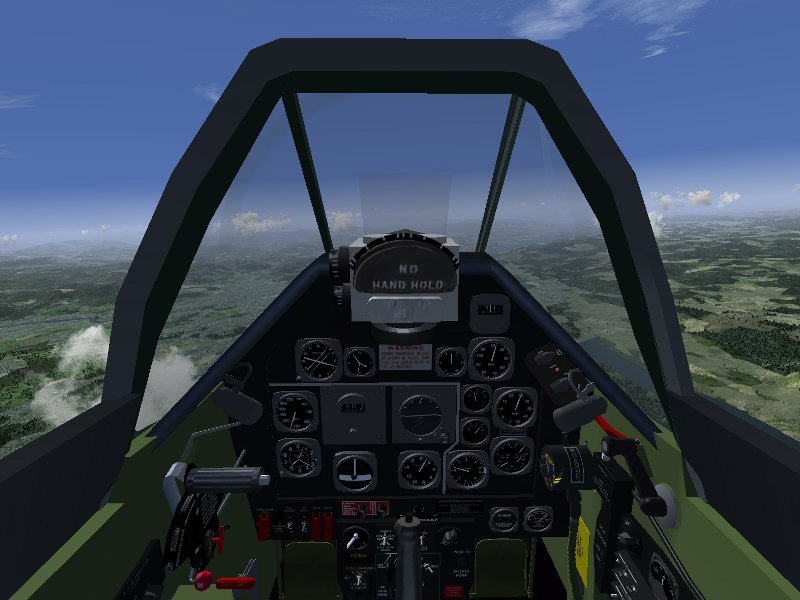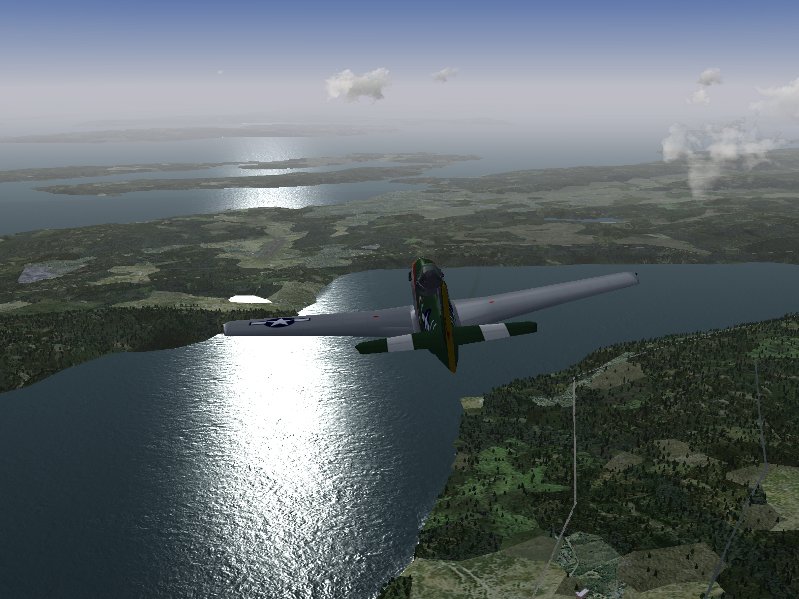North American P-51 Mustang
 | |
| Type | Military aircraft |
|---|---|
| Author(s) | Jim Wilson & Hal Engel |
| FDM | YASim and JSBSim |
| --aircraft= | p51d |
| Status | Production |
| FDM |
|
| Systems |
|
| Cockpit |
|
| Model |
|
| Supports |
|
| Download |
|
The P-51D Mustang is a piston single engine fighter aircraft.
Aircraft Help
Flying Hints
NOTE: The yasim config file for this aircraft currently starts up with the booster in 1st stage. The following help is for the YASim model.
For the JSBSIm model use the USAF F-51D/K/H manual (Jul. 1952) for detailed procedures. This are available on-line from the link near the bottom of this page in the External Links section.
Take Off
- Set prop pitch to full increased rpm.
- Start engine with throttle at idle.
- Set BOOST stage one (CTRL-b keybinding cycles through stage 0 (off),1, and 2). Default startup for p51-d should have stage one already on.
- Set throttle to 40 inHG Manifold Pressure (MP).
- Be ready to actuate rudder. When the tail first lifts, the torque will pull the nose to the left.
- After tail lifts off slowing move throttle to full open which with stage 1 booster engaged should be about 61 inHG Manifold Pressure.
- Hang on. Stay on top of rudder control with small adjustments or you'll do a ground loop.
- Rotate at 150 mph or so.
Climb
- Back off MP to 46 inHG. *Adjust propeller pitch to 2700 rpm.
- Keep adding throttle as you climb to maintain 46 inHG until you hit full throttle.
- At 18,000 feet turn on second stage (hit CTRL-b) and back off throttle to 46 inHG.
Flying
- Trim and Cruise at about 2400 rpm.
- Do not exceed 2700 rpm sustained.
- Do not exceed 3000 rpm military power (aerobatics)
- Do not exceed 3500 rpm in dives.
- Do not exceed 61 inHG Mainfold Pressure (military power), except 71 inHG for maximum of 7 minutes (war emergency power). Note that war emergency power is not for flying fast, rather it is for dogfighting at < 200mph.
Landing
- A single long sweeping turn from the downwind leg into a short approach seems to work best. Make sure you are below 250mph before starting the turn. Use forward slip as necessary to bleed off speed and altitude at the same time.
- Start applying flaps at 250mph, gear at 175mph, and full flaps at 165mph or less.
- Excessive braking can cause you to nose over. Some recommend raising flaps immediately after touchdown.
Performance Data
This information is gleaned from various sources: Maximum Speed: 437 mph
Cruise Speed: 363 mph
Landing Speed: 100 mph
Initial Climb Rate: 3475 feet per minute Sustained Climb Speed: 175 mph
Service Ceiling: 41,900 (with 2nd Stage booster).
Stall Speed (9000lbs) Gear/Flaps Up: 102mph Gear/Flaps Down: 95mph
Development status/Issues/Todo
Outside:
New 3D external model is under way. 2-1-2014
The intent is to create an external model that is a solid 5 in the FlightGear rating system. All models are being built based on factory blue prints (my set has over 11,000 drawings). So the models will be extremely accurate and have lots of detail. Volunteers are welcome but I am expecting any work done to be of the very highest standard. There is tons of 3D related work that needs to be done and there are many very small 3D modeling projects that would make good starter projects and I am willing to mentor anyone that is willing and ready to do a good job.
Fuselage (updated 3-7-1014)
- External skin model - done.
- Internal skin model - done.
- Windshield and its external frame models - done.
- Doghouse model including inner passages, doors and heat exchangers - done.
- Exhaust fairing, pipes and cowl cutout models - done.
- Spinner model - done.
- Inner instrument panel model - done
- ToDo - Fuselage
- Air intake holes in the lower front area of the cowl need to be cut in.
- Visible formers and longerons inside the cockpit area need to be modeled.
- Canopy, canopy frame, tracks and other canopy hardware need to be modeled.
- Internal windshield and armor glass structure/framing needs to be modeled.
- Instrument hood needs to be modeled.
- Outer instrument panel needs to be modeled.
- Tail wheel, retract mechanism and doors needs to be modeled.
- Tail feathers need to be modeled.
Wing is nearing completion. (updated 3-7-1014)
- Ailerons - done.
- Flaps - done.
- Wing tip - done.
- Wing tip lights - done.
- Wheel well internal skin including front and rear spar models - done.
- Landing gear door models - done.
- Landing gear door hydraulics models - done.
- Main landing gear leg model - done.
- Main wheel & tire model - done.
- Gun fairings model - done.
- ToDo - Detail work on the wheel wells remains.
- Ribs missing.
- Longerons missing.
- Main gear hydraulics models missing.
- Aileron trim tab needs to be cut in and modeled.
- Gun chutes are cut in but need to be fully modeled.
ToDo - UV mapping, texturing, bump mapping and reflection mapping need to be done for everything.
- If anyone would like to help with this please feel free to contact me via a PM on the FlightGear forum.
3d Cockpit:
- When the new external model is done a mostly new 3D cockpit will be built out from the skin inward.
ToDo - YASim version will be removed.
Airplane of the Week/Month
The P-51D (JSBSim) was reviewed as 'Airplane of the Week/Month' on May 04, 2011 as follows:
P-51D (JSBSim)
Model
The JSBSim version of the P-51D comes with a very detailed 3d cockpit, down to various warning plaquettes. I think it conveys the feeling of being in a warbird very much. Based on a quick google image search, it looks pretty authentic to me.
Most of the switches are actually functional :-) For instance, some amount of fuel management is required for longer flights. The plane comes with a full working set of weapons, from guns via bombs to rockets - so tight dogfights are entirely possible. A full engine startup procedure is simulated. The exterior model is maybe not stunning, but nice enough for all practical purposes:
Flight characteristics
The JSBSim FDM of the P-51D is very detailed and is actually a joy to experience. As common with warbirds, engine torque is a major issue - try spinning up the engine suddenly in mid-air, and observe how the plane begins to roll unless you counter immediately with the ailerons. Accoding to Hal (the author), the performance characteristics in different altitudes is very faithfully reproduces (I lack the documentation to check, but I haven't seen anything implausible).
The plane is rather difficult to handle - it requires some skill to get it off the ground in spite of the engine torque forces, and even more skill to get it back to the ground in one piece onto the runway. Having the full control equipment (joystick and rudder pedals) is certainly a tremendous help - but it is possible with some practice to fly with just the mouse (avoid crosswinds though...).
The ground handling is tricky - ground loops (the propeller touches the ground) are a constant danger (apparently that really was and is an issue with the real plane) - so careful use of the brakes is a must, and sometimes its even necessary to throttle down immediately after the engine starts.
And, as a very special feature - the plane actually spins rather realistically - so be careful when approaching stall speed.
My personal wishlist
An added pdf manual describing all the features and providing some background info would be terrific - I have the feeling I'm missing so many details...
Things to experience
Let a tank run out of fuel, and experience a lovingly and realistically modelled engine stutter, followed by an emergency landing.
Related lists
External links
- The North American P-51 Mustang (vectorsite.net)
- 1952 USAF F-51D/H Pilots Manual
- Flight Characteristics of the North American P-51 Mustang: How to Fly the P-51 Fighter YouTube video about the B version (30 minutes).
| |||||

